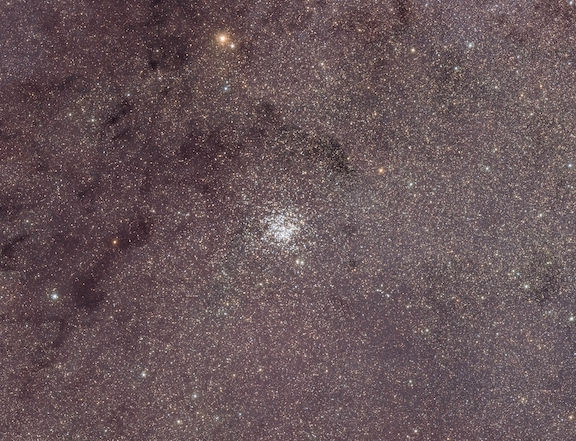M75 - Globular Cluster in Sagittarius | Astrophotography Tips & Pictures
- Antoine & Dalia Grelin

- Oct 27, 2023
- 4 min read
Messier 75 is a large globular cluster in the constellation Sagittarius, but it appears very small from Earth. It is one of the most distant and dense globular clusters in the Messier catalog. M75 is home to about 400,000 stars and has an age of about 13 billion years.
Object Designation: M75, NGC 6864
Also known as: N/A
Constellation: Sagittarius
Object Type: Globular Cluster
Distance: 67,500 light-years away
Magnitude: 8.5
Discovery: Pierre Méchain on August 27th, 1780
The M75 Cluster is and easy target for beginner astrophotographers, as long as you've got a long enough focal length for it. Although it has a large diameter, it does not have a large apparent size in the sky and can look smaller than anticipated in photographs. Being in Sagittarius, M75 is a nice Summer astrophotography target.
M75 Astrophotography with a RASA 8 and Color Camera
September 2023
M75 was a secondary target and was added to my sequence at the beginning of the night while waiting for my desired object to rise high enough in the sky. I only spent one hour capturing Messier 75, and the result turned out good enough that I didn't feel the need to spend more time on it. I do not see any hints of gasses or dust in the background with the current data, and doubt that there are any.
This picture was taken from the Bortle 2 skies of Utah Desert Remote Observatories with our f/2 RASA 8 telescope.

GEAR USED:
Camera: ZWO ASI2600MC
Telescope: Celestron RASA 8
Mount: 10Micron GM1000 HPS
Guiding: ZWO ASI 220MM Mini
Accessories: Celestron Focuser / PrimaLuceLab Eagle 5S
Processing: Pixinsight, with R-C Astro plugins. Final touches in Skylum Luminar Neo
ACQUISITION DETAILS:
Total Exposure Time: 1 hour
Exposure Time per frame: 30 seconds
Filters: N/A
Gain: 100
How to Locate M75
The M75 Cluster is located about 67,500 light-years away in the constellation Sagittarius, not far from the famous Teapot asterism.

Messier 75 appears bright but small when photographed with a telescope.

Visually, the cluster is very simple to spot using binoculars or any telescope, thanks to its bright and compact nature. Sadly, it is not possible to see much more than what looks like a fuzzy star because of its small size. A large telescope is needed if you are hoping to resolve individual stars.
Attached you can see a drawing (or sketch) of the M75 cluster done by Michael Vlasov. Michael used a Skywatcher BKP250 10" F/5 Newtonian telescope to observe the object and see this through the eyepiece.
Michael describes the cluster as looking like a comet, and says it is hard to resolve any individual stars in it.
M75 is located at the very edge of the constellation Sagittarius. The easiest way to find it is to follow the Ecliptic line West until almost reaching Capricornus.
The best time to observe and photograph the M75 Cluster is in August.
Messier 75 Cluster Information
Discovery

M75 was discovered by Charles Messier's good friend Pierre Méchain.
Méchain was observing the night sky late on August 27th and into the morning hours of the 28th, and spotted M75 for the first time.
On October 5th, Charles Messier decided to look for the object, but had trouble because of the moon peeking over the horizon. He waited until October 18th to look for it again and spotted it then! Messier was able to record precise coordinates and add the cluster to his catalog as the 75th object. He noted:
"Nebula without star, between Sagittarius & the head of Capricorn; seen by M. Méchain on August 27 & 28, 1780".
Messier 75 by NASA
On April 22nd, 2019, NASA and ESA released an image of Messier 75 taken by the Hubble Space Telescope. The field of view is approximately 1.84 x 1.33 arcminutes and you can see the entire cluster in it fitting nicely.
The image was taken in near-infrared and visible light using the Wide Field and Planetary Camera 2 and the Wide Field Camera 3.
The cluster appears beautiful, with a bright white core, and thousands of blue, red and yellow stars. So many individual stars are visible in this one picture!

Our Premium Astrophotography Course
Want to learn all aspects of astrophotography in the most efficient way possible?
The Galactic Course includes a LIFETIME membership that gives you unlimited access to all current and upcoming astrophotography content. Step into an ever-growing realm of knowledge and learn at your own pace. Make life-long friends and connections with other members, and get tips from instructors that truly care about your journey and progress under the night sky.
How to Process Messier 75
Processing M75 was very easy. Globular clusters like this with no nebulosity, large galaxies, or IFN in the background are very beginner-friendly, as it does not involve any weird tricks or the use of advanced processing techniques.
Below you can see what a single 30-second shot looked like.

The processing was very quick and only took 20 minutes or so. I did not need to use any masks, or remove the stars. For these types of targets, I follow my beginner processing workflow which you can access and use as well. It also contains raw data and walkthrough videos on how to process basic images. More advanced workflows are also available.
Utah Desert Remote Observatories
Messier 75 was photographed from a Bortle 2 sky using our RASA 8 telescope and one-shot color camera installed at Utah Desert Remote Observatories.
If you would like to permanently install your rig next to ours under desert skies, you can contact the owner at info@utahdesertremote.com
Messier 75 FAQ
What is M75?
M75 is a globular cluster.
In which constellation is Messier 75 located?
M75 can be found in the constellation Sagittarius.
How big is M75?
Messier 75 has an apparent size of about 6.8 arcminutes. It has a diameter of 134 light-years.
How far is Messier 75?
M75 is believed to be between 67,500 light-years away from Earth.
How long should my exposure time be when photographing M75?
We recommend taking 30-second exposures for globular clusters like this.
Should I use a filter to image M75?
M75, like most globular clusters without any nebulosity, is a good broadband target so you will not need any filter to capture it.
What equipment do I need to photograph M75?
You can capture this object with any telescope, but the larger the better!
Final Thoughts
Messier 75 is a bright but small target you can capture during the Summer. It probably is one of the least exciting globulars in the Messier catalog, but you might find it interesting if you use a much larger telescope than we did!
Have you imaged M75? If so, upload your picture in the comments! We'd all love to see your work :)
Clear Skies,
Galactic Hunter
GALACTIC HUNTER BOOKS



















Comments